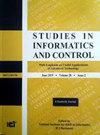基于Arduino板和MATLAB接口的基于特性阻抗的PV表征和MPPT
IF 1.1
4区 计算机科学
Q4 AUTOMATION & CONTROL SYSTEMS
引用次数: 1
摘要
本文章由计算机程序翻译,如有差异,请以英文原文为准。
PV Characterization and MPPT Based on Characteristic Impedance Using Arduino Board and MATLAB Interface
: Photo-Voltaic (PV) panels, whose maximal point is called the Maximum Power Point (MPP), provide extracted electrical power. In order to effectively exploit the PV System (PVS), they must be operated within the limits of this point. Later, it depends on the impedance of the connected load and on the Characteristic Impedance of the PV (CIPV) panel that varies with different climatic conditions. In a well-matched system, the load impedance is close to the CIPV and it operates normally at the MPP (via direct connection). Otherwise, coupling is fairly poor. The load impedance is different from the CIPV and, therefore, it requires the inclusion of MPP Tracking (MPPT) and a DC/DC converter as an adaptive load. In this paper, a new MPPT method based on CIPV matching is proposed. The algorithm structure is simple and easy to implement. This study focuses on how the PVS, tested and evaluated under varying load and climatic conditions, operates with the proposed MPPT controller. The present approach is characterized by a stable oscillation, with a slight fluctuation around the MPP. The controller integrates a variable step-size control and provides a rapid and precise convergence to the MPP. The simulation and experimental results prove the efficiency of the proposed method.
求助全文
通过发布文献求助,成功后即可免费获取论文全文。
去求助
来源期刊

Studies in Informatics and Control
AUTOMATION & CONTROL SYSTEMS-OPERATIONS RESEARCH & MANAGEMENT SCIENCE
CiteScore
2.70
自引率
25.00%
发文量
34
审稿时长
>12 weeks
期刊介绍:
Studies in Informatics and Control journal provides important perspectives on topics relevant to Information Technology, with an emphasis on useful applications in the most important areas of IT.
This journal is aimed at advanced practitioners and researchers in the field of IT and welcomes original contributions from scholars and professionals worldwide.
SIC is published both in print and online by the National Institute for R&D in Informatics, ICI Bucharest. Abstracts, full text and graphics of all articles in the online version of SIC are identical to the print version of the Journal.
 求助内容:
求助内容: 应助结果提醒方式:
应助结果提醒方式:


